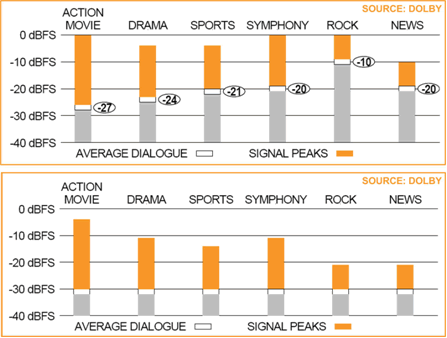 |
Loudness
Monitoring in a Digital System
Audio loudness
has been an issue with broadcasters almost since the inception
of broadcasting, with research dating back to the 1930s. A session
at this year's NAB Broadcast Engineering Conference (BEC, April
18-23, 2009, Las Vegas, NV) entitled "Loudness, Lipsync
and AFD for DTV" includes a paper, excerpted here, which
explores the use of ITU B.S. 1770 as a means to measure loudness,
its effect on dialog normalization as specified in the ATSC A/53
standard, and common practices in delivering Dolby Digital audio.
LOUDNESS
- Loudness is perceived by the listener, and while there is a
relationship between the intensity of sound to loudness, it is
not the same. The relationship of a listener's perceived loudness
and intensity can be better understood by considering how the
human auditory system works. As an audio wavefront enters the
ear, it is sampled through a series of auditory filters which
each have the characteristics of a bandpass filter. These filters
are known as "critical bands," in which the intensity
of the frequencies in each band is quantified and sent to the
brain for processing.
Like a bandpass
filter, each critical band also has an associated bandwidth, which
at the lower end of the frequency spectrum is around 90 Hz, increasing
to over 1 kHz at the upper end of human hearing. Within a critical
band, there is a compression-like action that affects the way
the intensity of the energy is quantified prior to being sent
to the brain. This compression is nearly logarithmic, requiring
ten times the intensity of energy in the critical band before
there is a perceived doubling of loudness.
LOUDNESS
AND PROCESSING - advancements in analog audio technology have
allowed development of efficient multi-band processing, aiding
in the delivery of sound to the end user. While such processing
has helped maintain a high average percent of modulation, it has
been at the expense of dynamic range, and has created a competition
of stations wanting to be the loudest in a market. In today's
digital environment, there is no need, or advantage, in processing
audio to maintain a high average percent of modulation. In contrast
to analog audio delivery, digital delivery allows for high signal
to noise ratios, large dynamic ranges, and wideband responses
that allow for delivery of sound as intended by the artist, not
limited by the requirements of transmission.
 ITU-R
BS.1770-1 - with the goal to deliver to the listener the highest
quality audio at a consistent loudness, two tools now exist for
systems using AC-3 audio coding: ITU-R BS.1770 and Dolby Dialog
Normalization. BS-1770 Annex 1 specifies an algorithm for measuring
multi-channel loudness. While the formal document only references
a maximum listening environment of 5.1 channels, the algorithm
is scalable up or down as required by the mix. This scalability
is accomplished by processing each channel of sound, excluding
the low frequency effects channel (LFE), through a series of components
before being summed. ITU-R
BS.1770-1 - with the goal to deliver to the listener the highest
quality audio at a consistent loudness, two tools now exist for
systems using AC-3 audio coding: ITU-R BS.1770 and Dolby Dialog
Normalization. BS-1770 Annex 1 specifies an algorithm for measuring
multi-channel loudness. While the formal document only references
a maximum listening environment of 5.1 channels, the algorithm
is scalable up or down as required by the mix. This scalability
is accomplished by processing each channel of sound, excluding
the low frequency effects channel (LFE), through a series of components
before being summed.
The block diagram
shown illustrates the BS.1770 algorithm for a 5.1 channel listening
environment, highlighting the four components applied to each channel:
Pre-filter:
accounts for the acoustical effects of the listener's head;
RLB filter:
Leq(RLB), Revised Low Frequency B response curve is used instead
of the Leq(A) that was originally specified for use to determine
Dialnorm. The major difference from the Leq(A) curve is that the
low frequency range is wider, and the high frequencies do not
roll off;
Mean square:
calculates the energy in the channel as integrated over an interval
of time. For the purposes of BS-1770-1, the interval of time used
for this calculation is the full length of the material used in
testing;
Gain:
applies a weighting to each channel before the summing occurs.
In essence, the primary channels (left, right, center) have a
weighting of 1.00, where the surround channels have a weighting
of 1.41.
 DOLBY
DIALOG NORMALIZATION - in the production process, sound
engineers typically process the audio for the material. That
is to say, the audio processing used for a symphony would be
different than processing of a rock and roll band's performance.
Dialog is then mixed into the material relative to the primary
sound, while maintaining a lower than peak (0 dB relative to
full scale, denoted dBFS) level. Consequently the dialog level
for different types of program material will have different
levels. DOLBY
DIALOG NORMALIZATION - in the production process, sound
engineers typically process the audio for the material. That
is to say, the audio processing used for a symphony would be
different than processing of a rock and roll band's performance.
Dialog is then mixed into the material relative to the primary
sound, while maintaining a lower than peak (0 dB relative to
full scale, denoted dBFS) level. Consequently the dialog level
for different types of program material will have different
levels.
In the upper
graph of the figure to the right, some typical types of program
material and the associated dialog levels as found by Dolby
Laboratories in their research are shown. By normalizing the
dialog level to a fixed value, specified as -31 dBFS for AC-3
(Dolby Digital), loudness between differing materials is perceived
by the listener as being equal. The lower graph of the figure
shows the material identified in the upper graph after normalization.
Normalization does not occur in the mix by the sound engineer,
but instead is accomplished by setting the Dialnorm metadata
value in the AC-3 bit stream. When the listener's decoder receives
the Dialnorm value, the decoders gain is changed, acting as
if the listener has changed the volume of their sound system.
This paper
is authored by John Hartwell, Hartwell Consultants, and is included
in its entirety in the 2009 NAB Broadcast Engineering Conference
Proceedings, available on-line from the NAB Store (www.nabstore.com).
Audio recordings of the BEC sessions are also available for
purchase - for more information, visit the NAB Show Online Learning
Center at http://www.nabshow.com/2009/education/onlinelearningcenter.asp.
For additional conference information visit the NAB Show Web
page at www.nabshow.com.
 NAB
Satellite Uplink Operators Training Seminar NAB
Satellite Uplink Operators Training Seminar
October 5 - 8, 2009 Washington, DC
This four-day course is designed to instruct about uplink operational
practices, which minimize the risk of satellite transmission
interference. This is an important course since the FCC rules
require that a trained operator be present at all times during
transmissions, either an earth station site or designated remote
control point. Go to http://www.nab.org/satelliteSeminar/
or Contact NAB Science & Technology Department at (202)
429-5346 or ccolerid@nab.org
for information about the NAB Satellite Uplink Operators Training
Seminar. If you are interested in sponsorship opportunities
for this event contact NAB Advertising at (800) 521-8624 or
advertising@nab.org.

The
May 4, 2009 TV TechCheck is also available in
an Adobe Acrobat file.
Please click
here to read the Adobe Acrobat version of TV TechCheck.
|

